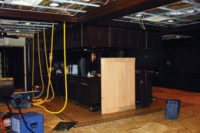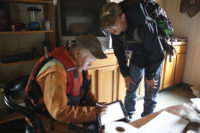Prepping for Disaster: The R&R Q&A




Who better to get advice from on the challenges of working catastrophic events than the professionals that have been doing it for years. Here’s what Art Diamond, Property Restoration Inc., and Mike Terrell, Ohio Valley Restoration, had to say.
With spring storm and hurricane season now upon us, many restoration contractors across the country can expect an uptick in catastrophic work. Take for instance, some of the big incidents from 2014, like in August when record rainfall hit the metro-Detroit area, flooding thousands of homes. Flash floods also hit Arizona in October. And prior to 2014, some notable catastrophes include the 2013 Calgary floods and the destruction from 2012’s Superstorm Sandy. Would you be prepared for the uptick in work when the next big catastrophe hits your area?
To better give you an idea on what you’ll need to take advantage of during an expected increase in work during the storm and hurricane season, we reached out to a few restoration contractors that have experience working in these catastrophes. Here’s a look at what Art Diamond, Property Restoration Inc., and Mike Terrell, Ohio Valley Restoration, had to say:
On notable catastrophes worked on in the past:
Diamond: There have not been as many lately, at least for us. But we did work in the Brooklyn and Staten Island area from Hurricane Sandy. We also did a few large jobs over the previous 2 years from heavy rain storms just north of the Catskill Mountains at a ski resort. We have done rain events in New Jersey, Pennsylvania, Ohio and Virginia. We spent 6-plus weeks working the floods in Cedar Rapids, Iowa. We have worked the hurricanes in Houston, Baton Rouge, South Padre Island, (and spent) 3 months in New Orleans after Katrina.
Terrell: (We’ve) traveled to all of the major storms since 1999. Our company is “built to travel.”
On the usual scope of the work:
Diamond: In most of those hurricanes and flood events we were providing mitigation efforts to include demolition and drying. Some of them, we were responsible for the drying efforts and monitoring only. Some jobs were partnered with other restoration companies that we are friends with. Some jobs were equipment rental only. And on one occasion we provided estimating and scoping services to a property owner in New Orleans after Katrina.
Terrell: During these CAT events we have done residential, commercial and industrial work from hotels to hospitals, daycare to nursing homes, as well as hundreds of residential jobs. Our part of these out of town catastrophes is extraction, cleanup and dry out.
On the challenges of responding to a catastrophe:
Diamond: Manpower is always an issue, both at home and at the storm site. Housing and food can be very difficult, sometimes not. Katrina required us to bring an RV and food and water. Other places like Houston and Cedar Rapids had hotels and food readily available. Financing jobs can be a challenge depending on situations. In most cases we were on big enough jobs or by being partnered up with others made it easier to manage the number of jobs. Bigger jobs are easier than multiple smaller jobs. In most cases we can get our hands on necessary equipment if we didn’t have what we need.
Terrell: Doing work on the road and managing a catastrophe at home are very different. While they present some of the same issues, if you have prepared and maintained your CAT plan, you can easily triple your volume of work at home and not go insane. When traveling to do work, the issues will vary by type of storm. In the aftermath of a hurricane such as Sandy, you will find housing, food and fuel to be your main issues along with traveling back and forth to the job site. During Hurricane Sandy, we had one crew that traveled as much as 3 hours a day just to go get fuel for the other vehicles. Labor during hurricanes can be easier to find because of the number of people put temporarily out of work.
On the importance of pre-planning for catastrophic events:
Diamond: We always try to preplan as much as possible, but the storms are unpredictable and the work flow at home at the time of storms is unpredictable. I take each storm opportunity on a case-by-case basis. As an example, we bought more equipment and a trailer last summer for the season and there was not a storm to go to. Having a core group of workers that you can bring from home to augment a local workforce is key in prep of out of town work. Definitely get into it slowly and use your networking and partnering opportunities to get your feet wet. Don’t bite off more than you can chew, some guys have gone bankrupt from this kind of work and the risks related to it.
Terrell: It is the difference between a highly profitable CAT event, where you can help hundreds of people and boost the financial health of your company, or a financially disastrous one if you have not pre-planned or pre-planned poorly. We know of several companies that did not withstand their poor planning efforts when they responded to Hurricane Sandy.
On other things that are notable when preparing for disaster:
Terrell: If you are traveling, make sure to prep your people well. They, and their families, need to know what they are in for (i.e., hours, working days/weeks away from home, how they get their paychecks, etc.). It’s the little stuff that adds up. In a nut shell, with proper planning, training and networking, you should be able to do a much larger volume of work and avoid the catastrophe after the catastrophe.
Looking for a reprint of this article?
From high-res PDFs to custom plaques, order your copy today!








